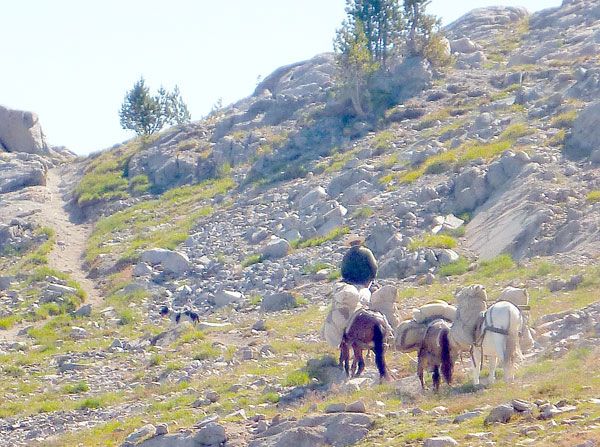Mules help with hiking
Published 11:07 am Friday, August 30, 2013

- A string of pack mules carry camping gear on the trail between Swamp Lake and Copper Creek on the Lostine-North Minam Loop recently. (DAVE BRITTON Wescom News Service)
Mules can make all the difference during a hike in high country
Hefting 30 pounds is no big thing.
Sometimes.
Hauling a few grocery bags from your trunk to your kitchen, for instance, barely rates as aninconvenience.
(Unless you drop the eggs.)
Now, cram all that stuff into a backpack.
And then carry it for, say, 30 miles over a weekend, climbing 8,500-foot passes and fording streams and ducking under low-hanging alder limbs along the way.
Do that and you’ll know, and remember with rare intimacy, every last ounce.
Your shoulders will never forget the experience, certainly.
Nor will the points of your pelvis where the backpack straps hug.
And of course your feet.
Your poor feet, which bear the whole punishing load with every plodding stride, might never forgive you.
Avoiding all this misery, of course, is why we have mules.
Not the only reason, I suppose, but surely it’s among the better ones.
I can attest to this since the weekend of Aug. 16-18, when I went on my first backpacking trip in the Wallowas when I didn’t have to lug my tent and sleeping bag and other wilderness accouterments.
I devoutly hope it won’t be my last such journey.
To say that having mules bear your gear makes hiking easier is akin to saying that it’s easier to get around on a motorcycle than on a tricycle.
Although the more apt comparison, at least from a backpacker’s perspective, might be this one:
Employing a packstring reminded me of that moment, after a long stretch of hiking with a full pack, when you reach camp, unshackle yourself, and then take those first few steps, blissfully relieved of the burden that seems to add pounds with every passing mile.
Now imagine the whole trip is like that.
You’ll understand, then, why I’m forever in the debt of my father-in-law, Howard Britton, who hired a packer from Eagle Cap Wilderness Pack Station for our three-day, 27-mile loop between the Lostine and Minam rivers.
I have perhaps indulged in hyperbole here.
But only of the slight variety.
To be sure, walking 27 miles through the Eagle Cap, a chunk of ground with a conspicuous shortage of gentle terrain, requires a considerable amount of exertion even if you’re carrying only a daypack weighing maybe seven or eight pounds.
But shedding 30 pounds of dead weight pretty much eliminates that sense of unending drudgery that afflicts most backpackers at some point during a long outing.
If nothing else the mules simplified the chore of packing.
Except that’s not wholly true.
It was simple in the sense that, unlike every other backpacking trip I’ve taken, I suffered not so much as a twinge of remorse as I stuffed items into my pack.
This same luxury, though, created a different sort of conundrum.
Although each mule can carry up to 120 pounds, the weight must be divided, as close to evenly as possible, between the animal’s two sides.
(Having a mule haul your supplies is wonderful so long as the mule doesn’t get out of balance on a switchback and send those supplies tumbling down a thousand-foot cliff. I don’t know what a tent or a cookstove would look like at the bottom but I doubt either would be usable. Not to mention the mule. And there’s a lot of switchbacks, and cliffs, in the Eagle Cap.)
And so, on the eve of our trip, I had to figure out how to wedge about 10 more pounds into my pack (a nylon duffel bag, actually).
This is rather like a pauper trying to decide how to spend a Powerball jackpot.
For a backpacker it requires a similar, well, adjustment in outlook.
Binoculars?
The heavy old metal-framed pair I inherited from my granddad never had a chance on previous trips.
This year they went right in, sandwiched by the full-size pillow and the soft cooler filled with bacon and steak.
Freeze-dried dinners, the staple of every past hike?
Superfluous.
They’re too light, anyway. You can’t balance a mule with Mountain House lasagna.
I don’t mean to imply that I dislike traditional backpacking.
Neither the nagging pain of pack straps abrading my shoulders, nor an ill-timed blister, has ever diminished, even in a minor way, my joy at traveling on foot through Oregon’s largest wilderness area.
But the absence of those ailments is a pretty fine thing, as well.
It helped too that except for the final 2and#64257; miles down the West Lostine River to Two Pan Trailhead, our route was through a section of the Wallowas I hadn’t visited.
I always have a particularly keen sense of anticipation about hiking through unfamiliar territory, am always invigorated by the prospect of fresh vistas.
What we didn’t see much of was people.
And although I’m no hermit, I didn’t miss the sometimes hectic atmosphere of the Lake Basin – to be fair, that’s about the only place in the Eagle Cap likely to be crowded – any more than I lamented the lack of shoulder soreness.
Our foursome – Howard and I were joined by his son, Dave, and Dave’s son, Tyler, who’s 10 – started at Bowman Trailhead along the upper Lostine.
On Friday, Aug. 16 we hiked west for 10 miles to North Minam Meadows and we passed just six people on the way – a father and son, and a group of four on horseback.
The route is ideal for the first day of a trip, it seemed to me. It starts with a typically long-but-gentle Wallowas climb, along Bowman Creek and past Brownie Basin (and the Chimney Lake trail) to Wilson Pass.
The latter half of the day’s hike was all downhill – and quite a long ways down it is, about 2,400 feet of elevation loss to the meadows at 5,450 feet.
North Minam Meadows is renowned, and it deserves its reputation. It seems to me the archetype of an alpine meadow, with its expanses of lush grass, its backdrop of granite peaks and ridges, and the crystalline North Minam River meandering through.
The river looked especially fetching with three cans of beer propped in a shaded eddy beside our campsite.
This was the handiwork of Ty, our packer – his backwoods version of a chambermaid putting chocolates on our pillow.
Chambermaids don’t as a rule wear spurs, however. Nor are they accompanied by a cow dog named Hank – appropriate, but not, Ty told us, inspired by the beloved canine of children’s literature.
Besides picking an ideal camp for us both Friday night and the following evening at Swamp Lake, Ty, and his mules, handled all the heavy work.
Both mornings we simply repacked our duffel bags, placed each on a square of canvas, and started hiking.
Ty wrapped the bags, loaded them on the mules and started off down the trail – or, rather, up, as we had to climb 2,500 feet on Saturday, passing Steamboat Lake en route to Swamp.
Saturday was similarly lonesome, and peaceful. Other than a group of about a dozen people at Steamboat, we passed just two hikers in seven miles. And at Swamp Lake, as at North Minam Meadows the night before, we were alone.
A thundershower pelted our tents an hour or so before dusk but it was a benign storm, and one with a silver – or rather, pink – lining, in the form of a gorgeous sunset that transformed the remnant clouds into rosy sculptures.
On Sunday morning we climbed the ridge southwest of the lake, crossed a nearly treeless upland where views extend east as far as Aneroid Mountain and west to China Cap Ridge, then started the long descent to the West Fork Lostine.
This is quite a scenic route, even by the lofty standards of the Eagle Cap Wilderness.
The trail follows first Elkhorn Creek, then the much larger Copper Creek, through a series of alpine meadows where the wildflower palette includes, among many others, yellow (monkeyflower, cinquefoil, groundsel), orange (Indian paintbrush), red (more monkeyflower, more paintbrush), white (alpine pussytoes, pearly everlasting) and purple (aster, penstemons).
Between the two streams there is one of the finer trailside springs in the Wallowas, a foot-wide stream of frigid water that gurgles from the base of a basalt dike.
The final few miles along the much more heavily traveled West Lostine Trail is something of a dusty, monotonous slog, as the culmination of backpacking trips tend to be.
Yet when we emerged from the woods onto the gravel road at Two Pan the duffel bags, loaded with the heavy gear that had made the weekend about as luxurious as it’s possible to be when you’re 10 miles from the nearest road, were neatly packed, like well-cut stovelengths, in the bed of Dave’s pickup.
When I slipped the straps of my daypack off my shoulders I realized something that struck me, in that instant, as a minor miracle.
I had pretty much forgotten I was even wearing the thing.
You don’t – indeed you cannot – forget 30 pounds which are trying, always trying, to force you to genuflect, as punishment for your failure to pack light.




